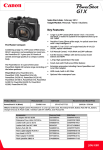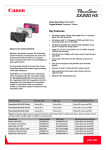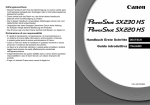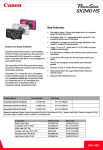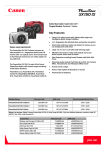Download Canon Digital IXUS 220 HS
Transcript
Technologies Explained – IXUS 220 HS EMBARGO: 7th February 2011, 06:00 CET HS System The HS System represents a powerful combination of a high sensitivity sensor and highperformance DIGIC 4 image processing. Designed to provide excellent image quality and advanced low light performance, the HS System can produce significant advantages over non-HS System models as listed below: Improved image quality in all situations – The HS System can capture images with up to 60% less noise than standard, non-HS System cameras at all ISO speeds. High ISO sensitivity photos taken with previous cameras exhibited significant amounts of noise and grainy detail, especially in low light. In contrast, the HS System can detect and capture more detail and significantly reduce noise, resulting in more beautiful and true to life shots. Low Light performance – The HS System truly excels in low light conditions and is able to preserve the atmosphere of the moment in dark scenes. Common low light problems such as capturing well exposed subjects against almost invisible, dark, night-time backgrounds or capturing blurred subjects due to slower shutter speeds can now easily be conquered. The ISO range is further extended using Low Light mode, reducing camera shake and subject blur in even darker conditions. Shooting at a reduced Megapixel resolution, the camera chooses an ISO speed between 100 and 6400, allowing users to capture a scene as they see it. Wider ISO range – The HS System can leverage the excellent performance of its high and low ISO settings in order to capture the ambience of any scene with exceptional image quality using up to ISO 3200. When using Smart Auto mode users can take advantage of an increased ISO range up to ISO 1600 (previous Automatic modes supported ISO 800 or less), enabling users to take pictures using available light without having to manually extend the ISO speed. Dynamic Range – The increased sensitivity of the HS System allows it to capture a wider dynamic range with greater variation in brightness when compared to the results of non-HS System models. High speed functions High speed functions enable users to capture both fast moving action and scenes that would otherwise be very difficult to achieve: Handheld Night Scene – To capture scenes in very dark conditions, the camera will take a high speed sequence of shots and then combine them into a single image with the least possible blur and the best possible exposure. Best Image Selection – Captures a sequence of high speed shots at 3MP resolution and then automatically selects only the best one to be recorded in the memory card. The best image is selected according to criteria such as facial expression or subject movement. That way a user can take advantage of the camera’s high speed to capture a great shot in a challenging situation, without wasting time trying to find the best image from the burst before deleting the unwanted versions. High-speed Burst mode - Shoots a continuous burst of images every time the shutter is released, capturing a number of similarly composed images to ensure you capture fast paced action. Super Slow Motion Movie - Utilises the strengths of the CMOS sensor to record VGA resolution footage (640 x 480 pixels) at 120 fps or 320 x 240 pixels at 240 fps. It provides a great way to slow down fast-paced action like sport and can be used to analyse a golf or tennis swing. Smart Auto mode Smart Auto mode is the ultimate automatic shooting mode, which makes use of multiple Canon developed technologies including Scene Detection, Motion Detection, Face Detection and Advanced Subject Detection. It allows everyone to obtain the best result by simply pointing the camera at a subject and pressing the shutter button. Smart Auto mode uses Scene Detection Technology to determine the shooting scene by analysing subject brightness, contrast, distance and overall hue. The camera then selects the most appropriate scene type from 32 variables, applying the best settings for optimum output. In Smart Auto mode, a colour icon indicating the type of scene detected and the lighting conditions is shown on the LCD monitor. Smart Auto also includes enhanced i-Contrast and Smart Flash Exposure, which ensure that brighter or darker areas are captured in sufficient detail in the final image by suppressing overexposed highlights and underexposed shadows. This enables any user without any knowledge of camera settings to take great quality photos. Advanced Subject Detection A further feature of Smart Auto mode, Advanced Subject Detection allows the camera to identify a moving non-human subject, such as a pet, and track it - ensuring it remains in focus and well-exposed until the shutter is released. Face Detection Technology Face Detection Technology makes it easier than ever to produce superb people shots. This advanced system quickly and accurately detects faces in a scene – then optimises camera settings so that everyone looks their best. With the ability to detect up to 35 faces in a frame, it’s great for group photos as well as portraits. These cameras include the following Canon Face Detection Technologies: Face Detection AF: Sets the focus for the faces in your people shots – not just the closest subject Face Detection AE: Optimises exposure for faces in all lighting conditions – useful for backlit scenes or indoor shooting Face Detection FE: Guards against washed-out faces when using the camera’s flash – perfect for close-up shots in restaurants, clubs or other dimly lit locations Face Detection WB: Optimises white balance for natural-looking skin tones which remain true to life regardless of skin colour and lighting conditions Red-Eye Correction: Automatically eliminates the unwanted effects of flash photography after the shot is taken. At the touch of a button in playback, natural-looking eyes can be instantly restored Smart Flash Exposure (FE) Canon’s Smart Flash Exposure intelligently controls the power and usage of the onboard flash to ensure natural results in a variety of conditions. By using the focusing distance as well as shooting scene information, an optimum balance between the ambient light of the scene and flash power is achieved. When shooting in very bright conditions, shadows sometimes appear on a subject’s face – these can be detected by the camera and flash can be used to eliminate them. When shooting at close distances overexposure is avoided by effectively sensing how reflective the subject is as well as reducing the flash power to compensate for the close shooting distance. Servo AF/AE When a subject is moving towards or away from the camera and the shutter is halfpressed, Servo AF/AE will track it continuously - ensuring that the subject is in focus and well-exposed when the shutter is finally pressed. Motion Detection Technology Motion Detection Technology automatically detects motion in the shooting scene. If movement is detected the camera will increase the ISO sensitivity and shutter speed to minimise blur and optimise image quality. Genuine Canon Lens technology Developed using the same processes and high quality standards employed to manufacture its range of professional lenses, Canon’s compact cameras benefit greatly from Canon’s heritage in lens design, capturing sharp, high-resolution images every time. The IXUS 220 HS has a 24mm 5x ultra-wide optical zoom with optical Image Stabilizer for greater versatility when shooting. The wide coverage of the lens allows more of a scene to be captured - from portraits to panoramic landscapes. Full HD Movie including Stereo Sound Full High Definition video at 1080p resolution is recorded at 24 fps with Stereo sound ready for playback in excellent quality on HD displays. Miniature Effect in Movie Miniature Effect can also be applied to movie recording, providing the ability to capture model-like scenes in 720p resolution. Miniature Effect gradually blurs the top and bottom, or the left and right, of the scene, emphasising perspective. The user can select the frame rate the movie is shot at (6fps, 3fps and 1.5fps options available) so that when the movie plays back it gives the effect of watching a movie of a time-lapse miniature model. Dynamic optical Image Stabilizer (Dynamic IS) Dynamic optical Image Stabilizer is a technology which was initially developed for Canon video cameras and is now being incorporated into Canon’s PowerShot SX220 HS, PowerShot SX230 HS, IXUS 310 HS, IXUS 115 HS and IXUS 220 HS digital still cameras. It is designed to produce steadier video footage by compensating for low frequency vibrations, such as camera shake generated when filming whilst walking. Optical Image Stabilizer Canon’s highly-effective optical Image Stabilizer (IS) technology prevents image blur by dramatically reducing the effects of camera shake. In situations where image blur due to camera shake is more likely – such as in darker conditions or when shooting with the zoom extended – the optical Image Stabilizer can help images remain sharp through minute vibration gyros which detect camera movement caused by hand shake. These signals are processed by a single-chip IS controller, which discriminates between hand shake and intentional camera movements. Signals are then sent to the IS unit, which moves one of the lens elements accordingly to re-align the light rays and cancel out the effects of camera shake. The IXUS 220 HS features a 4-stop IS System which helps preserve the sharpness of an image without needing to use a tripod for added stability. Smart Shutter Smart Shutter mode uses Face Detection Technology to allow users to take both group shots and self-portraits more easily and in a more relaxed way. The shutter can be triggered remotely in three different ways: Smile Detection: Triggers the shutter when the camera detects a smiling face within the frame Wink Self-Timer: Triggers the shutter two seconds after the subject in the frame has winked, removing the need for a remote control FaceSelf-Timer: Allows perfect group shots or self portraits by automatically triggering the shutter two seconds after a new face has entered the frame Tracking AF To keep focus on subjects in motion, or to help achieve a creative composition, Tracking AF mode gives photographers the ability to select objects from the centre of the frame and track them if they move, or if the frame is recomposed. DIGIC 4 Processor Canon’s DIGIC 4 (Digital Imaging Core) processor manages all of the camera’s primary functions to optimise operating efficiency. Advanced image processing algorithms deliver superb image detail and colour reproduction with accurate white balance and minimal noise. High-speed processing results in outstanding responsiveness, rapid auto focus and extended continuous shooting ability. Creative shooting modes The new PowerShot SX series and IXUS models feature additional shooting modes that make it easier to capture high-quality, creative shots. These modes include: - Movie Digest: When set in this mode the camera will film for up to four seconds before each still shot is taken at VGA resolution. Then it will combine all the clips captured from the same day into a single movie. This provides users with a view of the few seconds before every shot was taken, giving an alternative and fun way to save those moments in a movie. - Movie Digest Playback: Allows the playback of movies shot in Movie Digest by date. When playing back these movies, it is possible to jump forward or backward in four second units with designated button operations. - Creative Filters: A choice of filter effects allows users to have fun with their photography by creating images with greater impact or a different mood: o Toy Camera Effect – darkens the edges of the image, as well as carrying out image processing to increase the differences in contrast of the overall image, to re-create the effect of an older style or pinhole camera. Additionally, three effect types can be selected to attach to the image: Warm, Standard or Cool o Monochrome – allows users to shoot in three types of monochromatic effects: black and white, sepia or blue o Miniature Effect – blurs the top and bottom, or left and right edges of an image to give the subject a scale model-like appearance o Fish-eye Effect – mimics the distortion of a fish-eye lens with one of three levels of strength (weak, medium, strong) o Super Vivid – saturates the colours of an image for an intensely colourful effect o Poster Effect - reduces the levels of colour gradation to give the image the retro feel of vintage posters o Miniature Effect in Movie – gives the effect of a very narrow depth of field making the scene look like a small-scale model. When shooting, designated portions of the top and bottom (or right and left side in vertical shooting) of the image are blurred, while the rest of the image remains in focus - Image Group Playback: High-speed Burst mode (as above) shoots a large amount of similarly composed images. However, depending on the objective when viewing, it may not be necessary to play back all of the images. Therefore images shot in one high-speed burst are grouped, and it is possible to only display the first frame. This can be set in the playback menu’s group display setting.








